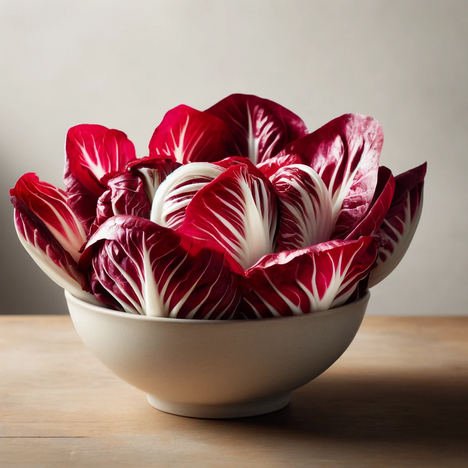Radicchio

What is radicchio?
Radicchio is a plant that originally comes from Italy. It is also known as red chicory or red chicory. It has round or elongated heads with purple leaves and white veins. It is usually eaten raw as a salad, but can also be boiled or fried.
Radicchio is a vegetable that contains many vitamins and minerals. It is particularly rich in vitamin K, vitamin C, folic acid and potassium. Vitamin K is important for blood clotting, vitamin C strengthens the immune system, folic acid promotes cell growth and potassium regulates blood pressure. Radicchio also contains fiber, which aids digestion, and antioxidants, which protect the body from free radicals.
What are the benefits of radicchio for dogs?
Radicchio can have several health benefits for dogs when fed in moderation. Here are some of them:
- Radicchio can help control weight as it is low in calories and makes the dog feel full.
- Radicchio can promote dental health as it cleans the teeth and massages the gums when chewed.
- Radicchio can reduce inflammation in the body as it contains antioxidants that work against oxidative damage.
- Radicchio can reduce the risk of anemia as it contains vitamin K, which is important for blood formation.
What are the disadvantages of radicchio for dogs?
Radicchio is not toxic to dogs, but it can have some disadvantages if fed too much or too often. Here are some of them:
- Radicchio can cause digestive problems, such as bloating, diarrhea or vomiting. This is due to the high fiber content and bitter taste of radicchio.
- Radicchio can cause allergies, such as skin rashes, itching or breathing difficulties. This is due to the high content of mustard oil in radicchio.
- Radicchio can unbalance a dog's diet if it displaces other important nutrients. This is because dogs are mainly carnivores and only need vegetables as a supplement.
How do I feed radicchio to my dog?
If you want to feed your dog radicchio, there are a few things you should bear in mind:
- Buy organic radicchio or wash it thoroughly to remove dirt and pesticides.
- Cut the radicchio into small pieces or grate it finely to prevent it from being swallowed.
- Only give your dog a small amount of radicchio as a snack or as a side dish with their food. A rule of thumb is that vegetables should not make up more than 10 percent of your dog's daily calorie intake.
- Introduce radicchio slowly into your dog's diet and observe his reaction. If your dog does not like radicchio or has digestive problems or allergies, leave it out.
Radicchio is a purple leafy vegetable that is safe for dogs and may have some health benefits. It is rich in vitamins, minerals, fiber and antioxidants. It can contribute to weight control, dental health, anti-inflammation and anemia prevention. However, radicchio should only be given in small amounts and as a supplement to your dog's diet. Too much or too often radicchio can cause digestive problems, allergies or nutritional imbalances. In addition, radicchio should always be clean and finely chopped. Whether your dog likes radicchio or not depends on his taste.
If you notice any signs of hypersensitivity or poisoning in your dog, you should see your vet immediately. We are not a substitute for a vet, but we try to be as accurate as possible. Every dog reacts differently and we recommend you get a second opinion or consult your vet if in doubt.
Stay healthy and take good care of your four-legged friend!😊